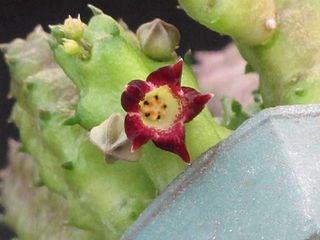Related Research Articles

Echinocactus is a genus of cacti in the subfamily Cactoideae. The generic name derives from the Ancient Greek εχινος (echinos), meaning "spiny," and cactus. It and Ferocactus are the two genera of barrel cactus. Members of the genus usually have heavy spination and relatively small flowers. The fruits are copiously woolly, and this is one major distinction between Echinocactus and Ferocactus. Propagation is by seed.

Rapid plant movement encompasses movement in plant structures occurring over a very short period, usually under one second. For example, the Venus flytrap closes its trap in about 100 milliseconds. The dogwood bunchberry's flower opens its petals and fires pollen in less than 0.5 milliseconds. The record is currently held by the white mulberry tree, with flower movement taking 25 microseconds, as pollen is catapulted from the stamens at velocities in excess of half the speed of sound—near the theoretical physical limits for movements in plants.
The Oxymonads are a group of flagellated protozoa found exclusively in the intestines of termites and other wood-eating insects. Along with the similar parabasalid flagellates, they harbor the symbiotic bacteria that are responsible for breaking down cellulose.

Ariocarpus is a small genus of succulent, subtropical plants of the family Cactaceae.

Obregonia, the artichoke cactus, is a genus of cacti with a single species, Obregonia denegrii. The species is endemic to the state of Tamaulipas in Mexico.

Pelecyphora is a genus of cacti, comprising 2 species. They originate from Mexico.

The Cactoideae are the largest subfamily of the cactus family, Cactaceae. Around 80% of cactus species belong to this subfamily. As of August 2018, the internal classification of the family Cactaceae remained uncertain and subject to change. A classification incorporating many of the insights from the molecular studies was produced by Nyffeler and Eggli in 2010.

Cacteae is a tribe of plants of the family Cactaceae found mainly in North America especially Mexico. As of August 2018, the internal classification of the family Cactaceae remained uncertain and subject to change. A classification incorporating many of the insights from the molecular studies was produced by Nyffeler and Eggli in 2010.

Lophophine is a putative psychedelic and entactogen drug of the methylenedioxyphenethylamine class. It is the α-demethylated homologue of MMDA, and is also closely related to mescaline.

Baynesia is a genus of plants in family Apocynaceae.

Lophophora diffusa, commonly known as false peyote, is a species of plant in the family Cactaceae and one of the only two species in the Lophophora genus. It is endemic to Mexico in the outskirts of Querétaro. This species contains zero to trace amounts of mescaline; pellotine, whose psychoactive effects are comparatively minimal, is the principal alkaloid. The species name diffusa refers to the flat tubercles that are outspread without the plant having prominent ribs.

Lophophora is a genus of spineless, button-like cacti native to Texas from Presidio county south right along the Rio Grande river to Starr County, Texas. Its range continues south through Northeast and north central Mexico to Querétaro in central Mexico. The species are extremely slow growing, sometimes taking up to thirty years to reach flowering age in the wild. Cultivated specimens grow considerably faster, usually taking between three and ten years to reach from seedling to mature flowering adult. The slow rate of reproduction and over-harvesting by collectors render the species under threat in the wild.

The peyote, scientific name Lophophora williamsii, is a small, spineless cactus with psychoactive alkaloids, particularly mescaline. Peyote is a Spanish word derived from the Nahuatl peyōtl[ˈpejoːt͡ɬ], meaning "caterpillar cocoon", from a root peyōni, "to glisten". Peyote is native to Mexico and southwestern Texas. It is found primarily in the Sierra Madre Occidental, the Chihuahuan Desert and in the states of Nayarit, Coahuila, Nuevo León, Tamaulipas, and San Luis Potosí among scrub. It flowers from March to May, and sometimes as late as September. The flowers are pink, with thigmotactic anthers.
Trichoblemma is a genus of moths of the family Erebidae. The genus was erected by George Hampson in 1926.
Homaloxestis is a genus of moths in the family Lecithoceridae. The genus was erected by Edward Meyrick in 1910.
Many cacti are known to be psychoactive, containing phenethylamine alkaloids such as mescaline. However, the two main ritualistic (folkloric) genera are Echinopsis, of which the most psychoactive species is the San Pedro cactus, and Lophophora, with peyote being the most psychoactive species. Several other species pertaining to other genera are also psychoactive, though not always used with a ritualistic intent.
Azaera is a genus of snout moths. It was described by William Schaus in 1913.
Azaera lophophora is a species of snout moth in the genus Azaera. It was described by Harrison Gray Dyar Jr. in 1912, and is known from Panama.

Peyonine is a beta-phenethylpyrrole made by Lophophora.
References
| This Herminiinae article is a stub. You can help Wikipedia by expanding it. |